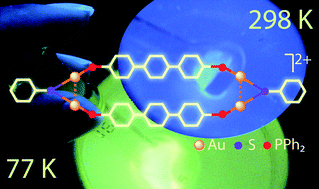Synthesis, structural characterization, photophysical properties and theoretical analysis of gold(i) thiolate-phosphine complexes†
Abstract
A series of luminescent dinuclear neutral complexes of stoichiometry [(AuSPh)2(PPh2-(C6H4)n-PPh2)] (n = 1, 2, 3) as well as their tetranuclear cationic derivatives [(Au2SPh)2(PPh2-(C6H4)n-PPh2)2](PF6)2 are reported. Their crystal structures have been elucidated by X-ray studies. These studies indicate that, for the dinuclear species, only when n = 1 the molecules exhibit intermolecular aurophilic interactions. None of the tetranuclear species crystallizes in their molecular form, due to the formation of aggregates through Au⋯Au interactions. The origin of the luminescence has been analyzed by computational studies indicating that the presence or absence of aurophilic interactions does not affect the luminescent behavior and that intraligand charge transfer processes which involve the thiolate and the diphosphine are responsible for the emissions. The result is in contrast with the thiolate–gold charge transfer processes which dominate the photophysics of gold-thiolate compounds and reveals the influence of the


 Please wait while we load your content...
Please wait while we load your content...